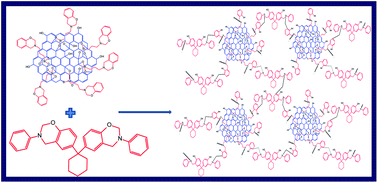Studies on dielectric properties of GO reinforced bisphenol-Z polybenzoxazine hybrids
Abstract
In the present work, an attempt has been made to reduce the value of the dielectric constant of bisphenol-Z (BPZ) polybenzoxazine (PBz) material by the reinforcement of graphene oxide (GO) into BPZ-PBz matrix by exploiting the concept of polarization to enable them to be utilized as dielectrics in microelectronics applications. GO-BPZ-PBz hybrid materials have been developed using BPZ-Bz and benzoxazine functionalized graphene oxide (GO-Bz) via a facile one step copolymerization technique. The GO-Bz is expected to function as a versatile precursor for polymer grafting through the formation of chemical linkages with the base polymer. The molecular structure of benzoxazine monomers and hybrid polybenzoxazines were confirmed using 1H and 13C NMR, FTIR spectroscopy and XRD patterns. The chemical composition of GO-Bz was characterized by X-ray photoelectron spectroscopy (XPS). Raman spectra were used to ascertain the graphitic nature of the carbon present in the hybrid matrix. The morphological properties of GO-BPZ-PBz have been explained using scanning electron microscope (SEM) and transmission electron microscope (TEM) images. Data obtained from dielectric studies infer that the value of the dielectric constant decreased with increasing the weight percentage of GO-Bz and the lowest value of the dielectric constant (k) of 1.95 was obtained for the 10 wt% GO-BPZ-PBz hybrid composite.


 Please wait while we load your content...
Please wait while we load your content...